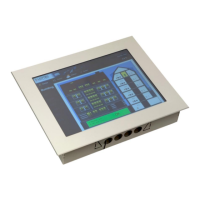L-VIS User Manual 120 LOYTEC
Version 6.2 LOYTEC electronics GmbH
Day of Week in Month: Day of week in month (numeric), indicates the n
th
occurrence of the current weekday in the current month, as in 2
nd
Wednesday in
July, or 3
rd
Monday in December. Pattern symbol F.
Day of Year: Day of the current year (numeric), starting with day 1. Symbol D.
Modified Julian Day: This numeric value can be thought of as a single number
that encompasses all the date-related fields. Rarely used, symbol g.
Extended Year: A single number designating the year of this calendar system,
encompassing all supra-year fields (for example the era). In contrast, the standard
year will start over at the beginning of a new era. Rarely used, symbol u.
Related Gregorian Year: For non-Gregorian calendars, this corresponds to the
extended Gregorian year in which the calendar’s year begins. Related Gregorian
years are often displayed, for example, when formatting dates in the Japanese
calendar, as in 2012(
平成
24)
年
1
月
15
日
. The related Gregorian year is usually
displayed using western digits, regardless of what numbering systems may be
used for other parts of the formatted date. If the calendar’s year is linked to the
solar year (perhaps using leap months), then for that calendar the related
Gregorian year will always be at a fixed offset from the normal calendar year.
For the Gregorian calendar, it’s the same as the standard calendar year. Symbol r.
Era Name: Era name for the current date, for example AD, as in 2017 AD of the
Gregorian calendar, or
平成
, as in
平成
29 (year 2017 in the Japanese calendar).
Note that the auto-formatter will automatically add the era name if necessary to
disambiguate the calendar year, even if the pattern template only requests the
calendar year and not the era explicitly. Pattern symbol G.
Quoted text: Available for raw date patterns only, allows to insert any static text
between date fields, for example dashes, commas, colons, or white spaces. When
inserted via the UI, the given text is automatically enclosed in single quotes, such
that characters which would otherwise be interpreted as field specifiers can be
used. When editing the pattern directly, it is recommended to quote static text in
the same way to avoid conflicts with field specifiers. When using the auto
formatter, field separation characters are inserted at the appropriate locations
automatically. Characters which are not field specifiers are ignored in this case.
9.5.7.3 Extended Patterns
For LVIS-3ME projects, there are some additional date pattern fields available, when the
option Enable all settings is checked in the extended project settings. These fields are not
supported by current LWEB clients, and therefore break compatibility of the project with
LWEB if used. However, they are expected to be available in a future version:
Year in “Week of Year”: Calendar year where the year transition occurs on a
week boundary. Can be used in conjunction with Week of Year, as in week 52 /
2017. Since the last few days of the last week of the year may already be part of
the next year, using the standard calendar year for this purpose will result in
wrong output (week 52 / 2018, which is a completely different date). Symbol Y.
Week of Month: Week number of the current month (numeric), starting with
week 1 for the week containing the first day of the month, usually ending with
week 5 for the last few days of the month. Pattern symbol W.
Week of Year: Week of the year (numeric). Note that the week number may be
locale dependent. While many locales use the ISO8601 standard for week
enumeration, some countries like the US are still using different week number
definitions which may result in different week numbers compared to the ISO
norm. To avoid confusion, it is recommended to avoid week numbers entirely.

